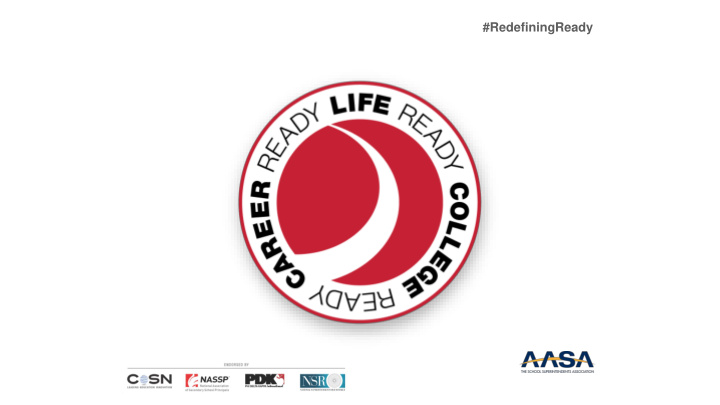



#RedefiningReady
Ready or Not: Broadening the Definition of Student Success 2
Readiness Gap 30 % 46 % 70 % Met Attained Enrolled in ACT a degree college benchmarks ACT (2017). The Condition of College and Career Readiness. 3 National Bureau of Labor Statistics (2016). TED: The Economics Daily; National Center for Education Statistics (2016). IES Fast Facts
4
5
Redefining Ready! College Ready and Career Ready Indicators
Redefining Ready! College Ready Indicators
Redefining Ready! Career Ready Indicators 8
District 214 Ready: District and Counseling postsecondary and career expectations 9
English Readiness Skills for Incoming Freshmen The following list is a guide to assist in prioritizing the foundations necessary for success in our introductory English course, Written and Oral Communication. Writing All students are able to do the following: Read Summarize author’s purpose for a reading. Use various types and styles of writing – i.e., persuasive, expository, comparison/contrast, and narrative. Make a clear central thesis/claim that guides the organization of the essay. Cite clear and specific textual evidence that supports the central claim. Write a well-structured essay that contains an introduction, body paragraphs, and conclusion. Employ appropriate transitions. Use conventions of standard written English. Proofread writing for errors. Grammar All students are able to do the following: Identify and understand the functions of the different Parts of Speech. Form conventional and complete sentences that avoid comma splices and fragments. Maintain subject-verb and pronoun-antecedent agreement. Communicate clearly in writing (basic sentence construction, punctuation, usage, and capitalization). Determine when particular contexts call for singular or plural possessive nouns and for plural or possessive nouns. 1 0
English Readiness Skills for Incoming Freshmen The following list is a guide to assist in prioritizing the foundations necessary for success in our introductory English course, Written and Oral Communication. Reading (both fiction and non-fiction) All students are able to do the following: Read closely in a moderately challenging text to identify explicitly stated information, ideas, or literary elements. Determine the best textual evidence for a simple conclusion. Identify the central idea of a passage with a single, clear purpose. Identify a simple relationship between information, ideas, or people (e.g., recognizing a basic comparison, contrast, or sequence). Determine the meaning of a relatively common word or phrase using clear context clues. Recognize a straightforward similarity or difference in a pair of moderately challenging passages. Annotate for a purpose (i.e., author’s purpose, ask questions, vocabulary, etc.). Speaking and Listening All students are able to do the following: Adapt speech to a variety of contexts and tasks, demonstrating command of formal English when indicated or appropriate. Engage effectively in a range of collaborative discussions. Use information to support their own views while acknowledging new information expressed by others. Integrate multiple sources of information and present in diverse media or formats. 1 1
Algebra and Geometry Readiness Indicators for Incoming Freshmen Students enter District 214 with differing experiences in math. To better help our middle school partners determine proper placement for their students, the following categories of mathematics can be used to assist in prioritizing the foundations necessary for success in a child’s first high school math course. Middle school instructors will be provided with a detailed list of statements that provide added detail for instruction. Number and Operations Students can understand types of numbers (integers, fractions, decimals), their properties and the correct order of operations. Students can perform computations correctly, with and without a calculator . Algebra and Functions Students can solve problems using algebraic expressions and symbols to represent relationships, patterns and functions of different types. Data, Statistics, and Probability Students can analyze data, understand descriptive statistics, make inferences, and determine the likelihood that certain events will occur. Geometry and Measurement Students can solve problems based on understanding the properties of shapes, such as triangles and circles, and the spatial relationships between angles and lines. 1 2
Algebra and Geometry Readiness Indicators for Incoming Freshmen Students enter District 214 with differing experiences in math. To better help our middle school partners determine proper placement for their students, the following categories of mathematics can be used to assist in prioritizing the foundations necessary for success in a child’s first high school math course. Middle school instructors will be provided with a detailed list of statements that provide added detail for instruction. Representations Students can communicate ideas and solve problems using verbal, numerical, symbolic and graphical representations. Problem Solving Students can solve abstract and practical problems using a variety of strategies. Students can monitor their problem-solving progress and evaluate the validity of answers in context. Reasoning Students can develop and use mathematical arguments and proofs to explore the truth of conjectures and justify conclusions. Communications Students can express mathematical ideas precisely. Students can communicate ideas coherently and clearly in the language and notation of mathematics. 1 3
https://www.youcubed.org/ Jo Boaler – Math Mindsets
New and Upcoming AASA National Initiatives • RR! Elementary and Middle School Readiness Indicators • SEL Cohort • Rural Literacy Grant Partnership with Waterford Learning • Legislative Advocacy • Legal Support • National Conference on Education • Leadership Network
www.RedefiningReady.o #RedefiningReady rg
Dr. David R. Schuler Superintendent, High School District 214 david.schuler@d214.org twitter: DSchuler1970 17
Recommend
More recommend